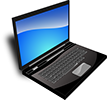1 – Contemporary Digital Audio Recording
Podcast: 52 Minutes, MP3 Format, Free Download
Audio Recording using Modern Equipment (Not Necessarily Expensive)
If you want to get good sound recorded for any reason, and you don't want to make the
mistakes that are frequently made by most people, listen to this podcast. Hear different
microphones to see what they sound like. Find out how you can get professional equipment at a fraction of the price.
Listening to poor quality sound, is like reading a book that is a photocopy of a photocopy, in poor light. Your brain just wants to give up. A poor microphone will produce sound that is the
equivalent of reading a photocopy of a book. The ears want to shut it off. The listener may not even understand why they don't like to listen to the material but will instinctively move to the next podcast.
The Shure SM 58 dynamic microphone is one of the most well known and versatile mics. It's
brother, the Shure SM 57 is the presidential microphone. It has been on the podium with the presidential seal for decades. These microphones sound great and take a beating. A condenser microphone on the other hand has a clean, clear sound that is perfect for accurately reproducing every aspect of a person's voice. Don't drop it or blow into it though. You may wreck it.
A mixer may be required if you are are going to interview someone and you need more than one microphone. If it's just one person, you can get away with a lot less equipment.
Almost any computer can be used to record audio. I used a Hewlett-Packard Netbook computer to record audio with no trouble. You should do a few things first, like put it into high
performance mode, turn off the WIFI, and use mains voltage with the battery. If the power
goes out, you won't loose all your recordings.
Audacity is the software of choice, if you don't want to spend gazillions of dollars for proprietary stuff. Audacity is totally free and it is fully functional for most recording purposes.
It also works on all computer systems – Mac, Windows and Linux.
If you want to record something that your computer is playing, like streaming videos, internet radio or even a running CD or DVD, you can.
It used to be that makers of computer sound cards would allow you to run Audacity or some other recording program at the same time as listening to something else. But manufacturers took away this ability by removing the “cross connect” function of sound cards. Older computer can do this but none of the newer computers can. To do this, you can connect an external sound capture device and cross connect it, connect an external mixer and press some buttons, or get a patch cord to physically redirect your sound card's output back into the input. Of course this is analog only, but it still works.
Once you have made a recording, you may want to store it in different kinds of formats. For example MP3 looses quality every time you re-edit it. There are other codecs that do not. If you are doing a lot of mixing you may want to save your audio files in OGG Vorbis format which does not loose quality every time you rework it. By listening to this podcast you may save yourself a lot of grief.
Updates:
- Since I did this podcast our new president has started using different types of microphones.
- You might find my piece on field recorders interesting – Cick here
Richard Roocroft
2009
A special thank you to Derek R. Audette,
Creative Commons, for the bumper music
used in this podcast
[Notice: This podcast is still available. However, the technology is very dated at this point. I have used the Tascam digital recorder for most of my recordings. My report is located here.]

Prev - Next
Rustymicrophone.com, Email: rustymicrophone@gmail.com